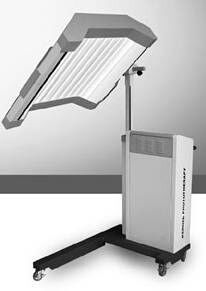Sunlight has always been known to have therapeutic properties. In the right doses, sunlight can sterilise tissues, accelerate healing, increase metabolic rate, improve immunity, help produce vitamin D, and act as a counterirritant. Long ultraviolet rays (between 4-3000 Å) are biotic, where short rays (3-2000 Å) are abiotic (Savage, 1954). Naturally, then, UV has been harnessed in a variety of forms as a therapeutic tool.
For general applications, though, a ‘tunnel’ was needed, because individual hand-held devices like the Kromayer, and the arc lamp, concentrated light over specific areas of the body.
UV doses were based on an initial erythema test. An E1 represented the baseline for each patient, and involved a timed dose to a small patch of skin with a specific and recorded UV set up. After this, doses were calculated based on the patient’s specific skin-type and the problem being treated. E2, 3 and 4 doses increased in strength and effect, sometimes resulting in blistering and prolonged skin pigmentation (sunburn).
Concerns over the risks of skin cancer with UV light saw it decline in popularity after the 1970s, and today UV is rarely seen in physiotherapy clinics. But before the widespread use of antibiotics and urban pollution initiatives, UV tunnels were an important way for people to have skin lesions treated and in gloomier climes experience the physiological effects of sunlight, however artificial.
Description provided by David Nicholls of New Zealand.
References:
Savage B. 1954. Preliminary electricity for the physiotherapist. London: Faber & Faber.

